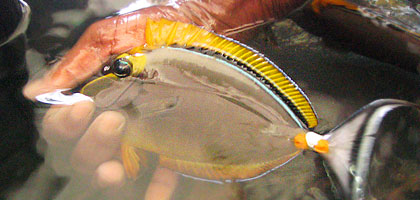
A worker scoops a Naso fish from a container of diving spoils.-Gea Swee Jean
Wild fish stocks drying up
TEH JOO LIN
KALMUNAI, SRI LANKA
Squatting within walls of woven palm fronds, the bare-shirted packer scooped up the twitching Naso fish. Gripping it firmly for an instant, he bit between its body and tail. He then spat and released the fish into a clear plastic bag half-filled with water before turning back to the container teeming with iridescent flashes - marine ornamental fish of various kinds.
This worker's bite-and-spit surgery to remove the Naso's spike is an old method of preparing the species for transport. Of late, he has been performing it with added urgency.
"The lorry usually comes every few days, but now it comes daily because the export company in Colombo wants fish now," said Mr Upali, 55, as he oversaw the packing of their latest diving spoils in Kalmunai. He heads a team of 24 divers.
Similar scenes along Sri Lanka's eastern coast indicate the marine ornamental fish trade has returned to the roaring business it was before the tsunami.
It is widely acknowledged that this trade started in Sri Lanka in the 1930s. The export of freshwater and marine aquarium fish has shot up steadily to about 750 million rupees (US$7.5 million) from a mere 30 million rupees in 1981.
Waving off the tsunami jitters to return to the sea seems like a good sign in the coastal regions where many are still struggling for normalcy. But there is a catch. The divers are surviving, but the fish are not.
There are no official estimates, but divers based in some spots on the eastern coast like Kattankudi are reporting their catch has dipped as much as 50 per cent. There, coral reefs were ripped up and hurled inland by the tsunami. With business as usual, they cannot catch enough fish to fulfill the orders, one boat driver said.
According to Mr Jerker Tamelander, marine programme coordinator of the World Conservation Union in Sri Lanka, the loss of marine fish could have resulted from mechanical damage that broke the "more fragile" corals.
"The fish will have to go somewhere else. If there is no good habitat nearby, they'll perish," he said.
When divers "take out young adults or even the juveniles", their reproductive capacities take another beating, he warned.
next »